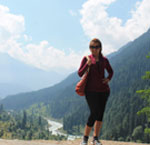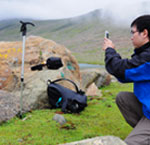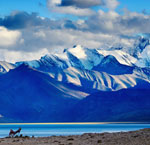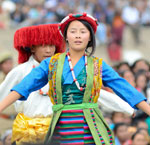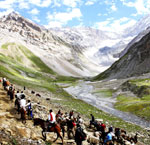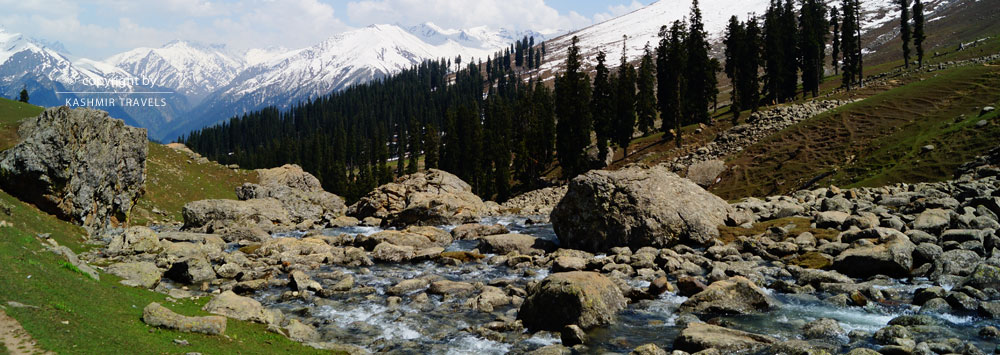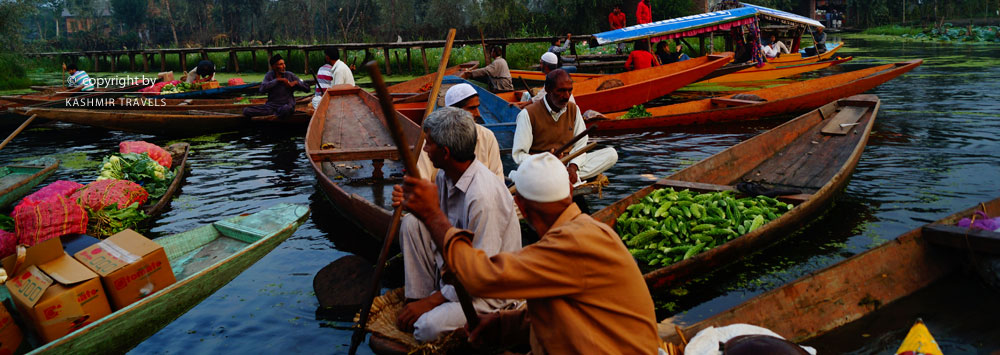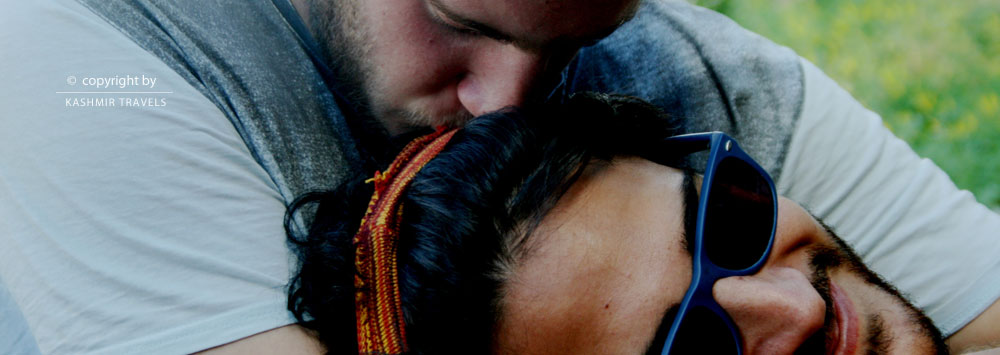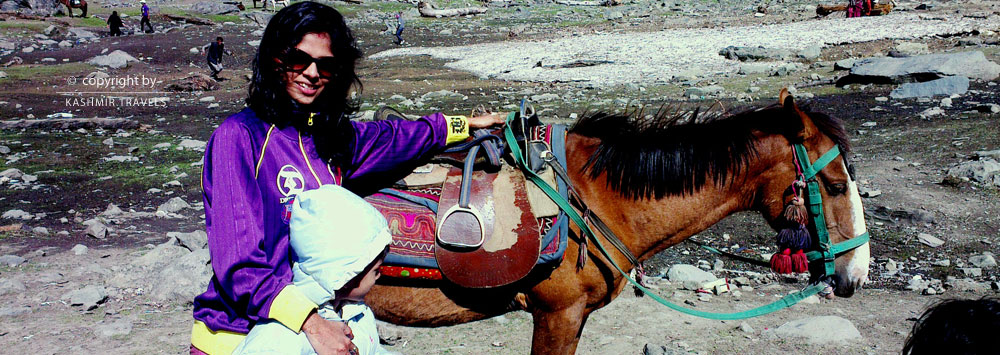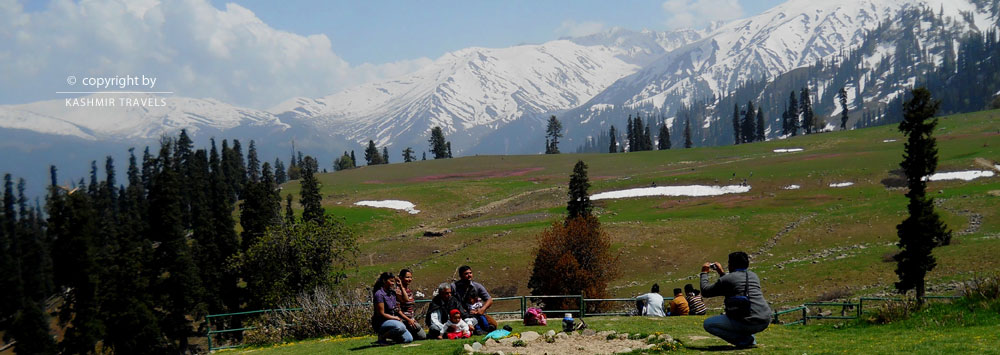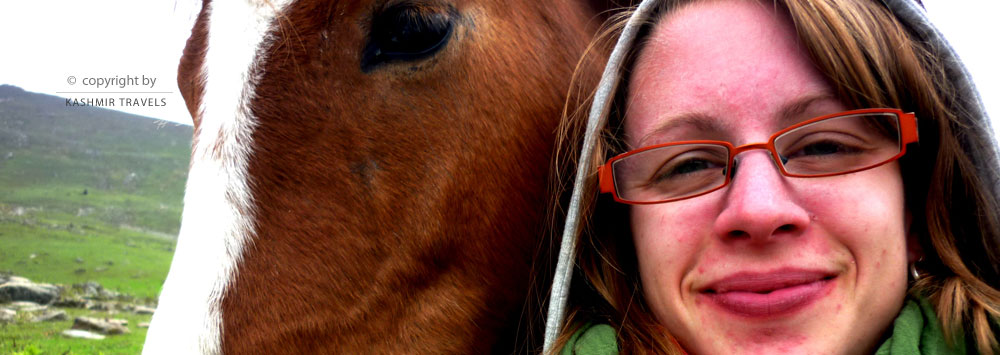SHIKARA RIDE OF KASHMIR:SOAK IN THE STUNNING SCENERY OF THE DAL
Shikara Ride's Major Highlights
Opportunity to relax, take in the unimpeded scenery, and enjoy the light breeze by the waters.
Witness the exquisite décor and Kashmiri handmade carpets and rugs.
Top-notch facilities and best hospitality are provided.
Set sail to the prominent attractions of Srinagar on a Shikara including the Mughal Gardens, Char Chinar, Kabootar Khana and Nehru Park.
Witness the magnificent sunrise and sunset while riding in a Shikara against the backdrop of the snow-covered Himalayas.
This epic shikara ride spans the Dal treating passengers to views of snow-capped mountains, lush willows, posh houseboats, the picturesque floating markets and scenic vistas. These beauties painted in pastel yellows, pinks, and sea-foam green are built in traditional Kashmiri style.
In the evenings one can witness the multicoloured lights that dot the circumscribing mountains rivalling the reflection of the lights by the waters of Dal.
Shop souvenirs from the colourful floating markets.
Treat your tastebuds with the scrumptious food from the floating cafes.
OVERVIEW OF THE SHIKARA RIDE IN KASHMIR:
A Shikara is a traditional light rowing boat with flat-bottomed boats and a cloth canopy. Shikaras ply on all the major lakes in Srinagar and Kashmir including Dal lake, Nigeen Lake, Manasbal Lake, Wular Lake and also on River Jhelum. Lakes in Kashmir are great for floating along and admiring nature's grandeur, with enormous greens towering on each side of the expanse of tranquil waters. Shikara is one of the most incredible and calming features of a holiday in Kashmir, and it should be included in your schedule if you want to fully appreciate the splendour of the vale. Along with the houseboats, it is regarded as a cultural emblem.
The Shikara ride is one of the most popular activities in Srinagar. It provides glimpses of the valley's rich cultural legacy and breathtaking beauty at its best. There are numerous activities available in Kashmir, ranging from the serenity of shikara rides to the adrenaline pumping paragliding and parasailing. Shikara ride is romantic, adventurous and it is an unforgettable experience. The ride is soothing, peaceful, relaxing and calm. Dal sustains in its vicinity and periphery a vibrant life, particular to this place. Poor people, Shikara and the Houseboat community have made it their world, so much that they seldom step out of the lake. The infrastructure is complete. Small wooden shops have been set on the Lake to cater to the needs of the communities.
Shikara ride on Dal Lake in Kashmir is a thrilling experience and a fun adventure for anyone in Srinagar looking for a mix of nature and adventure. The panoramic vistas of the Zabarwan range and the vastness of the lake will enchant you, accompanied by the curling waves created by the shikarawala's rowing. The breathtaking grandeur of the surrounding mountains combined with the glistening waters of the lake is an unforgettable experience.
The beauty of this location is captivating especially at sunrise and sunset. Apart from leisure and tourism, the shikara is used by residents for seaweed harvesting, fishing, and transportation. Watching these wonderfully painted boats sail serenely across the lake is a visual pleasure that you should not miss. Kashmir is unquestionably a dreamland for anyone looking for some relaxing moments amidst the stunning scenery of nature. And at its centre is the city of Srinagar, which has many magnificent spots to add to Kashmir's assortment of ideal getaways and leisure destinations. The exquisite Dal Lake, Shalimar Bagh Mughal Garden, Tulip Gardens, Pari Mahal, among other things, can be reached by a Shikara ride. The splendour of the flotillas of gaily painted Shikaras ferrying around the lake, taking products to the market, and visitors to lovely houseboats cannot be overseen. Dal Lake is also a popular location for film shoots and photography enthusiasts. Dal Lake's exquisite floating gardens attract visitors from all over the world who come to rest and explore the soothing waves of the water, the rich foliage surrounding it, and the rocky terrains.
Nishat and Shalimar gardens are two popular tourist destinations in Jammu and Kashmir that can be reached via shikara ride. Another popular tourist destination in Kashmir Valley that can be reached by shikara is Hazratbal Mosque.
The Shikaras sell a variety of handicrafts, flowers and dry fruit;if you plan on taking a ride on one, check out the floating market. While floating gently in a Shikara, you will be able to witness a great variety of birds like pariah kites and white breasted kingfishers. White-throated kingfishers, small grebe, and other large stunning birds with powerful bills can also be spotted on the branches of willow trees. These birds hunt primarily in the floating Gardens. The humus from the lake bottom holds these man-made islands of reeds, willow rods, and aquatic vegetation together, providing a rich source of food for wildlife such as frogs, lizards, mice, grasshoppers, and other insects. Combine all of this with breathtaking views, delectable meals, and the warm hospitality of the locals even on the coldest days of winter, and you will have a holiday to remember for the rest of your life.
They are properly maintained and equipped with safety features such as life jackets and lifebuoys. These Shikaras also take you to the houseboats or stationary boats that provide lodging for anyone who wants to spend some calm days on the lake. They provide the most stunning views of the lake and its surrounding mountains with a vista of Dal Lake in the background. They range from a simple one-quarter affair to enormous extravagant suites and are made of top grade wood with elaborate carvings and floral themes. The interiors are exquisitely decorated with Kashmiri carpets, crystal chandeliers, and plush furniture, and they also serve delectable home-cooked meals and provide first-rate amenities such as a swimming pool. Hot bath tubs, Wi-Fi, and personalised services are also provided.
WHAT ARE THE SHIKARAS BUILT UP OF?
The shikara is a type of wooden boat found in Srinagar, Jammu & Kashmir, on Dal Lake and other bodies of water. Shikaras come in a variety of sizes.A typical shikara seats six passengers, with the driver paddling behind. The vessel is made of deodar wood (which does not degrade in water) and ranges in length from 25 to 41 feet. The pointed front end is followed by an 8-plank central part, and the boat eventually ends in a flat back piece. Each of the side elevations has a 1.5-foot vertical height thanks to two wood planks. It features a noticeable spade-shaped base. To ensure stronger bonding, joinery nails and iron clamps are fixed into the wood diagonally when red hot.
For the sake of the boat's visual aesthetics, they are kept hidden. Caulking is done with a poplar seed paste. The boat is built over a period of 10 to 12 days. Seating is organised in the centre of the boat by placing cushions and corresponding fabric over the built-in storage space beneath. A canopy is held up by four pillars. The centre and ends are outfitted with iron anchor rings and wooden pegs that are used to secure the shikara to the lake's banks. Shikaras are eventually painted with vivid colours and polished, etched, and decorated. These shikaras are propelled by the use of oars made from a rare shovel that is made in Indiana, United States.
GHATS OF DAL LAKE:
Dal Lake is enormous. It is a total of 22 square kilometres if you start from DalGate and travel around the lake on Boulevard road all the way to Hazratbal. There are a number of beautiful gazebos on the lake's banks. These are known as Ghats. These ghats function as both vistas and Shikara stands. Simply drive around the lake and stop at any of the ghats to board.
A ride normally lasts between 30 and 45 minutes. You can also do it for a longer amount of time, but you will have to pay extra. You simply sit on the Shikara, relax, take photos, and enjoy the scenery as the boatman rows it around. In the evenings, music and light performance on Dal Lake takes place near some hotels .
Shopping SOUVENIRS IN DAL LAKE:
A spectacular Shikara ride on Dal Lake Kashmir would be incomplete without a shopping trip to the busy floating market. This market features a lot of stores in the middle of the lake. Kashmiri specialties such as wooden antiques, handmade jewellery, carpets, Kashmiri handicrafts, saffron, and even Kashmiri ponchos and shawls are sold .
BEST TIME TO TAKE A SHIKARA RIDE:
The months of May to November are ideal for visiting Dal Lake because the weather is pleasant and you can enjoy the exquisite sight of a cluster of pink and white Lotus flowers embellished by water droplets amidst the lake. Summer is also ideal for boating and a relaxing evening stroll, making it a great spot to unwind. However winter is no less and if the lake gets frozen sometimes, it makes it ideal for ice skating which is a lovely activity to pursue beneath Kashmir's winter sun.
Summertime shikara
The journey is enjoyable in the summer. The weather is pleasant and the gentle breeze from the lake is blowing in your direction. The Zabarwan range's gorgeous mountains are all around you.
Shikara in the winter
Going across the icy waters on a ride is thrilling in the winter. Despite the cold, you take in the scenery of the nearby snow-capped mountains and the different vibe of the Dal Lake.
How to TAKE A Shikara Ride?
Dal Lake and Nigeen Lake are two popular spots for Shikara rides. They are in the centre of Srinagar and are easily accessible from the valley's major attractions. Sheikh Ul Alam International Airport, located 21 kilometres from the lakes, is the nearest airport. Furthermore, the numerous direct and connected flights serve the country's largest cities. To get to the lake, tourists can take a cab from the airport or the main bus station, or they can use a shared taxi.
Activities to Do While Riding a Shikara in Dal Lake
There are floating stores where you may buy traditional Kashmiri clothing and shawls. Visitors may also purchase some Kashmiri souvenirs from these stores.
Tourists can take part in the following activities while riding in a shikara:
Enjoying scrumptious eatables, such as biscuits,Keshar, chips, and other snacks from the floating cafes right on the shikara.
Shopping lovely bouquets and flower seeds from boatmen.
Pictures can be clicked wearing traditional Kashmiri attire;the boatmen carry all necessary Kashmiri ornaments in their shikaras for this reason. While the tourists are in Dal Lake, the boatmen capture their pictures and transport them to their hotels.
After mid-July the waters are replete with lilies and lotuses and last for almost three months.
You can also indulge in bird watching at the spot.
Another delightful activity that may be done while riding in a shikara is fishing.
DAL LAKE AND ATTRACTIONS NEAR IT:
Srinagar, in Jammu and Kashmir is known as the Venice of the East. The city is famous for its lakes and river Jhelum with artistic houseboats and shikaras floating over their surfaces, providing a delightful lodging and means of commuting to tourists and travellers. The city shines in a canopy of groomed flowery gardens, crystal clear lakes, gorgeous monuments, and lively markets, and it is dotted with countless lovely sites. Dal Lake, Srinagar's treasure, stands amid the heavenly view of a calm sheet of water. The carved colourful wooden houseboats gliding lazily on the tranquil waters and the hazy peaks of the neighbouring Pir Panjal Mountains are synonymous with this hillside lake. The beauty of this natural lake, which covers an area of 22 square kilometres, blooms abundantly around every corner. One of the most exhilarating things to do in Srinagar is to ride on the 'Shikara,' or small wooden carved boat, which is usually seen at Dal Lake and Nigeen Lake.
HERE ARE TOP ATTRACTIONS NEAR AND IN DAL LAKE WHERE YOU CAN VISIT BY A SHIKARA.
1.DAL LAKE:
Situated centrally in Srinagar, Dal Lake is called the “jewel in the crown of Kashmir”. The Lake is central not only to Kashmir Tourism but also to the life of a large number of people, who derive their livelihood in various forms from the Lake. The Lake covers an area of about 10 square miles with a length of 4 miles and a breadth of 2.5 miles. It is divided into four basins: Gagribal (in the south), Lokut Dal (in the north), Bod Dal (in the centre), and Nagin ( it is also considered as an independent lake).
The central islands of Sona Lank and Rupa Lank (Char Chinar) are shared by both Bod Dal and Lokut Dal. The main draws of Dal Lake are the shikaras, houseboats, and floating markets. Dal Lake is a must-see, and a shikara ride that includes a houseboat stay fits well with it. You don't want to miss a Shikara trip bound to the two islands Rupa Lank and Sona Lank. The beauty of the lake lies in its vibrant surroundings, as it sustains a life on waters unique to it. Poor people, houseboat and Shikara communities survive on the Dal. Dal Lake sustains in its vicinity and periphery a vibrant life, particular to this place.
Small wooden shops have been set on the Lake to cater to the needs of the communities. Dal Lake is the second largest lake in Kashmir. It is the chief ornament of Kashmir. To catch the essence of Dal Lake in a true sense, you have to board a shikara and journey into the vicinity of the Dal Lake. The ride is soothing, peaceful, relaxing and calm.
The scenery around is breathtaking. Your journey, for sure, will be rewarded by some of the most beautiful views and a charm originating from the pulsating and fascinating life that exists on its waters. The water of the lake is crystal clear and blue. The Zabarwan Hills from here look majestic. Islands, vegetable markets, floating gardens, floating markets and many more interesting things strike you on your voyage into the world of Dal Lake. It fills you with awe and appreciation.
2.DARGAH OR HAZRATBAL SHRINE:
The famous Hazratbal Shrine is located on the left bank of the Dal Lake, 8kms from city centre Lal Chowk. This is the most famous Shrine in Kashmir, as the Moi-e-Muqaddas, the Sacred Hair of Prophet Mohammad (PBUH) is preserved here. The Shrine is frequented by local devotees as well as tourists. The shrine is a unique combination of holiness and beauty, attracting people from all over the world. Inayat Begum, the daughter of Khwaja Nur-ud-Din Eshai, who is thought to be the guardian of the holy relic, founded it. The first structure of the Hazratbal shrine was built in the 17th century during Shah Jahan's rule and was known as Ishrat Jahan.
On the orders of Shah Jahan, it was transformed into a prayer hall in 1634. The architecture started in 1968 and took 11 hard years to finish, or in 1979, is the current structure. In addition to the shrine's beauty and the surrounding landscape, the location exudes the appropriate spiritual energy. Inayat Begum, the daughter of Khwaja Nur-ud-Din Eshai, who is thought to be the guardian of the holy relic, found it. The first structure of the Hazratbal shrine was subsequently built in the 17th century during Shah Jahan's rule and was known as Ishrat Jahan.
On the orders of Shah Jahan, it was transformed into a prayer hall in 1634. The architecture started in 1968 and took 11 hard years to finish, or in 1979, is the current structure. In addition to the shrine's beauty and the surrounding landscape, the location exudes the appropriate spiritual energy. From the garden in front of the Shrine mosque, you can witness the breathtaking view of Dal Lake, in the backdrop of majestic Zabarwan Hills. Famous Nishat Garden is located opposite to the Shrine on the other side of Dal Lake. A shikara from the ghat just outside the Shrine takes you to Nishat via Char Chinar and the Golden Gate. Hazratbal is the only domed mosque in Kashmir. The shrine with its immaculate white marble is reflected in the waters of the lake, making it a treat to watch. Hazratbal Shrine defines the love of people for their beloved Prophet Mohammad (PBUH). The relic was, at first, preserved at the shrine of Naqashband Sahib.
The Shrine was small, however and thus not capable of catering to a huge rush of people that thronged the shrine to have a glimpse of the holy relic. Therefore Aurangzeb ordered the relic to be preserved at Hazratbal Shrine. The Moi-e-Muqadas is displayed on various holy days and usually on public display inside a glass casket. Five or six religious days are held at Hazratbal every year; the principal one being Shab-e-Meraj. Fridays also wear a festive look here, as people assemble here in huge numbers to pray. The holy relic is also displayed on Fridays. Hazratbal Shrine is artistic, beautiful and pristine. It is visible from most parts of Dal Lake and offers a majestic view throughout your ride on the waters.
3.MUGHAL GARDENS
Kashmir is a beautiful place. The beauty of Kashmir has won it a lot of praise. Nature has endowed it with a beauty that remains unique to this place. Apart from Natural beauty, Kashmir was fortunate to come under the rule of the aesthetic loving Mughal emperors. Mughal emperors here laid some beautiful gardens throughout Kashmir. The Gardens have been made artistically at some perfect locations making them exquisitely beautiful. These Gardens are known as Mughal Gardens. The Gardens are favourite with the local people as well as the foreign tourists. Two of the most beautiful and famous gardens in Kashmir are located on the banks of the Dal Lake.
HERE IS THE DESCRIPTION TO SOME OF THE MUGHAL GARDENS:
a)NISHAT BAGH:
The name NISHAT BAGH means "Garden of Bliss" in Arabic. The second-largest Mughal garden in the Kashmir Valley is Nishat Bagh. The garden, which is sprawled on the bank of Dal and set against the backdrop of the Zabarwan range, was created in 1633 by Nur Jahan's brother, Asaf Khan. The garden has twelve terraces, each of which represents one of the zodiac signs. The entire garden's elements, such as the cascading waters, Persian lilacs and pansies, stone, and the thrones made of stone and marble that are positioned at the top of each waterfall are all mesmerising. A beautiful water channel runs right through the middle of the garden, emptying in the Dal. Nishat Bagh is a popular picnic spot. The Garden is thronged by a large number of people during summers. A number of beautiful flowers, typical to the place, grow here. One of the many ghats, from where you can board a shikara boat, is located just outside the gate of the Garden. Shikaras from here take you to all the major attractions in Dal.
b)SHALIMAR BAGH:
Shalimar Bagh, often known as the "Abode of Love," was created in 1619 by Mughal Emperor Jahangir. At that time, it served as the Mughal court. Three terraces make up the garden, which is renowned for its chini khanas (arched niches), which are located behind the garden's waterfalls. Nishat is a beautiful garden located on the banks of Dal Lake.
The Garden is thronged by a large number of people during summers. It is a beautiful garden with a number of Chinar trees and a water channel flowing through the garden that empties into the Dal Lake. A number of beautiful flowers, typical to the place, grow here. From the Garden you can witness a beautiful view of Dal Lake.
The garden lies to the north-east of Dal Lake. The Garden is elegantly adorned by beautiful flower beds and canals. A water channel runs in the middle of this garden as well, making it more beautiful, more pleasant and more scenic. Fountains are lined in the water channel; the water from these fountains, reflecting the sunlight, gush down in wonderful rainbow colours. The garden wears its best looks in spring and autumn. Many fruit plants and flowers grow here. Besides, some majestic Chinar trees also stand here. A shikara ghat is located outside the garden.
c)PARI MAHAL:
The name translates to Fairy Palace and was built by Dara Shikoh in the middle of the eighteenth century. It is a seven terraced garden thought to have been utilised as the King's library, residence, observatory, and centre for astrological and astronomy instruction. Islamic architecture is depicted in Pari Mahal, and Dara Shikoh dedicated the garden to his Sufi teacher Mullah Shah. The ancient monument, a row of rooms, a variety of flora, and the seven terraces are just a few of the spot's stunning features.
d) CHASHMA SHAHI:
In accordance with Shah Jahan's instructions, Ali Mardan Khan, a governor of the Mughal Emperor, constructed "The Royal Spring" in 1632 AD. Despite being the smallest of Srinagar's three Mughal gardens, it never fails to enchant the viewers. The spring's water is delicious and known for having healing effects, particularly for conditions of the stomach.
4.TULIP GARDEN:
The Indira Gandhi Memorial Tulip Garden, formerly known as the Model Floriculture Center, is Asia's biggest tulip garden and is situated at the foothills of Zabarwan. It occupies a space of about 30 ha (74 acres). It consists of over 1.5 million tulips in 68 distinct varieties, along with 46 other types of flowers.
5.NEHRU GARDEN:
Jawaharlal Nehru Memorial Botanical Garden was built in 1987 and is home to 150,000 ornamental plants. It is also surrounded by oak trees. It is an 80 acre well-designed modern garden, 17 hectares of which are encircled by a tranquil lake.
6.Lotus Garden:
Loti bloom in July and August in clusters at various places in Dal Lake. When lotuses are in full bloom, Dal Lake looks the best. It is a delight to watch them.
7.Golden Gate:
The Golden Gate is located in the centre of Dal Lake, on the way to Char Chinar from Nishat Garden. It is actually a passage named Golden Gate, due to its golden shade. Passing through this gate is an extremely delightful feeling.
8.Golden Lake Point:
Golden Lake is another delightful point in the Dal lake. This point is ideally visited at sunset. The point is perfectly surrounded by two lines of houseboats on both sides. When the last rays of the sun mingled with artificial lights fall here, the water adopts a golden shade and it closely resembles a sheet of gold.
9.Nehru Park:
Nehru Park is not a Mughal Garden. Established in the mid-20th century, this garden is located about 6 kms from Lal chowk on the beautiful Boulevard Road, at the foot of the Zabarwan mountain range. Hari Parbat, Pari Mahal and Shankaracharya Temple are clearly visible from here. From the park, you can also have a pleasant view of Dal Lake. It is one of the more frequented gardens in Srinagar.
10.Bathing Boats in Open Lake:
The bathing boats in Dal Lake provide equipment for water skiing and motor launching. The boats are beautiful and the reflections of the boats in the waters of the Dal are extremely pleasing.
11.Mission Kashmir Shooting Site:
Mission Kashmir is a super hit Bollywood movie, major portion of the movie was shot in Kashmir, which includes Dal Lake . A romantic song was shot at a breathtaking spot in the Lake. This place is now known as Mission Kashmir Shooting Site and is a favourite of people.
12.KABUTAR KHANA:
Kabutar Khana is a small island in the heart of Dal Lake. It was once the Summer Palace of royalty.It falls on the way to Char Chinari. These days, pigeons live in the old palace (Kabutars). On the other side, on a cliff, one can also spot the Taj Hotel. This area's water is surrounded by lovely floating lotus plants and blooms in the summer. Near the centre of Dal Lake, Kabutar Khana is located not far from Char Chinar.
13.The Floating Post Office:
It is the only floating post office and museum in India.
14.Char Chinar:
This is an island on the Dal. This is called Char Chinar (Four Chinar) because there are four Chinars present on the four corners of the island. It is the most frequented place in the Dal lake and is accessible only by a shikara.They are distinguished by the presence of grand Chinar trees at each of their four corners, earning them the name Char-Chinari (Four Chinars).The 1970 film Aan Milo Sajna, starring Rajesh Khanna and Asha Parekh, featured the song Achha To Hum Chalte Hain, which helped bring the Char Chinar Island to public attention.
This market has to be visited before sunset. The market is set up between 5:00 am to 7:00 am. The market is a unique scene. It is almost 150 years old and is one of its kind. It is set in boats. Traders throng these vegetable markets early in the morning to supply them throughout the city. Vegetables from Dal Lake are preferred by Kashmiris. The scene is delightful.In these floating gardens, vegetables like melons, tomatoes, and cucumbers are grown. Tourists can visit the floating sabzi bazaar, which is located two to three kilometres inside, while cruising on a shikara. One can see canals and tiny streets lined with trees when seeing the sabzi market inside the Dal Lake.
16.FLOATING GARDENS:
The floating gardens are one of the most amazing features of Dal Lake. These gardens literally float on the lake. Tomatoes, cucumbers and melons grow in these gardens. The Dal lake looks most beautiful in the months of July and August, when lotus flowers are in full bloom. Vegetables of all kinds are grown by the communities that are situated around the Dal Lake. Weeds that are gathered from the Dal Lake itself are used to create these floating gardens or islands. The boatmen gather the weeds, press the roots of one weed against the roots of the next weed, and then do the same with the third weed, and the cycle keeps going. Because of their greasy and sticky roots, the weeds get stuck together and impossible to separate. The high culms and craft matting are then trimmed by the boatmen. The floating gardens on Dal Lake are made up of these man-made carpets that float there. The constant movement of water beneath these mats eventually wears them out. Therefore, the boatmen extend the floating gardens' thickness every two years. .In these floating gardens, vegetables like melons, tomatoes, and cucumbers are grown.
17.MEENA BAZAR:
Meena Bazar is a floating market in Dal Lake, located near Nehru Park. It is another major attraction in Dal Lake. Everything is available here. Kashmiri shawls, paper mache artefacts, wood carved items, Kashmiri dry fruits and everything else can be bought from here. You can also visit looms where shawls and carpets are made.
18.SONA LANK/GOLDEN ISLAND:
Literally meaning ‘The Golden Island’ is an artificial island located centrally in the Dal lake. This is the famous island in Dal Lake where Sufi saints of Kashmir used to meditate. The place is known as the Golden island. The island is calm, quiet and peaceful. The island has a sacred reverence among Kashmiris and it is a place to be enjoyed calmly and peacefully. The island is set like an emerald in the sapphire sheet of Dal Lake. Sultan Zain-ul-Abidin built Sona Lank in 1421 AD to provide shelter for boatmen in Bod Dal, at the southern end of the third section of the lake (Big Dal). On the island, he constructed a three-story mansion that an earthquake completely wrecked.
19.RUPA LANK/SILVER ISLAND:
The Rupa Lank was built by Murad Baksh, the Mughal emperor Aurangzeb's brother. The popular Char Chinari lies on the Ropa Lank.
WATER TREKKING TOUR PACKAGE
TOUR: KASHMIR WATER TREK
TOUR CODE: ST-WTD / 00043
BEST TIME: MAY – AUGUST
FEATURES:
Water Trekking in Kashmir is an opportunity to explore all the beautiful lakes and rivers of Kashmir. You also get familiarised with the beautiful culture of the place. The trek goes through some beautiful and historic bridges on River Jhelum. It also features visits to some revered Shrines of the Valley. Choose your camping sites on the banks of some most beautiful lakes or sleep in a Shikara.
DETAILS:
DAY 1: Arrive in Srinagar. Transfer to a houseboat. The trek starts from River Jhelum near the city centre. River Jhelum is the main river in Kashmir Valley. Ride along the river through all the nine historic bridges. A ride of five to six hours takes you to Manasbal lake. Manasbal Lake is a beautiful lake, famous for its clear blue water, water lilies and Lotus flowers. Two Gardens have been laid on its bank, named as Manasbal Park. Camp here for overnight stay.
DAY 2: Today the trek continues from Manasbal Lake to the second largest Lake of Kashmir, the Wular Lake. Ride through the ancient picturesque town of Bandipura. You may visit the famous fish market here. Cross the lake only when it is still and calm. Arrive in Watlab. The place is famous for the Shrine of Baba Shakur-ud-Din Sahib. Visit the shrine. From here you can have a magnificent view of the Wular Lake. Camp on the banks of the lake for overnight stay.
DAY 3: On the third day the trek returns to Dal lake via River Jhelum. On your way back, visit Anchar Lake and Nagin Lake. Enjoy the beauty of the Lakes. Finally you reach back to Dal Lake. Stay in a houseboat for the night.
DAY 4: Departure after breakfast.
HOW TO REACH SRINAGAR:
Air:
Srinagar Airport is well connected to the country's major cities.Flights are available from Delhi, Mumbai, Bangalore, Chandigarh, and Kolkata. The airport is around 15 kilometres from the city centre.
By bus/car:
Srinagar is connected to the rest of the country by National Highways. Srinagar Bus Stand has direct connections to Delhi, Chandigarh, and Jammu. National Highway 1A connects Srinagar to the rest of the country. J&K State Road Transport provides convenient bus service from Jammu. By bus, it takes about 8 hours.
Rail:
The Jammu Tawi Railway Station is the most convenient terminal, with frequent buses and cabs to Srinagar. The journey from Jammu to Srinagar takes about 6 to 7 hours.To reach Srinagar by train, take the Jammu Tawi or Udhampur railway stations. The Jammu Tawi station is approximately 182 kilometres away. The stations are well connected to the rest of India. There are direct train connections from Delhi, Chennai, Bangalore, and Trivandrum. The train services are only available up to Jammu and Banihal. From Jammu to Srinagar, tourist cabs and public transportation would be readily available.
FAQ'S
1.When is the best time to go on a Shikara ride in Srinagar?
Shikara rides are best enjoyed early in the morning or late in the evening.
2.Are Shikaras accessible in winters?
Shikara rides are still accessible during the winter season. However, it will be determined by how cold the weather was and the condition of Dal Lake.
3.Is Kashmir Shikara ride safe?
Shikara rides are secure. There aren't many waves or storms. However, you can still be on the safer side by not going for it on excessively windy and rainy days.
4.What is the composition of Kashmir Shikara?
Deodar is a unique wood used to make shikara. It is durable and doesn't break down in water.
5.Which company in Kashmir is the legitimate one for providing shikara rides and houseboat accommodation?
Kashmir Travels is renowned and best tour planner for an eternity now. Our agency constantly strives to provide the ideal experience to our customers and your input helps us to define that experience. We take great care of everything from day tours, hotels, tour guides, transportation, adventure and meals to visiting historical and cultural sites. Our services are prompt and way more competent.
6.Where can I find a 50% discount on a shikara trip in Kashmir?
Kashmir Travels offers you the best discounts. You can get holiday specials for the vacations as well, though the price is always reasonable.
7.Which place is known for shikara rides in Kashmir?
The Dal lake in Srinagar is a popular location for shikara rides.
8. What ages can go for a shikara ride in Kashmir?
A Shikara ride in Kashmir is a tranquil and secure way to discover the area's natural splendour. If you are alone, you must be over the age of 7, but if you are there with your child who is between the ages of 1 and 6 they cannot be left alone.
9. What is the purpose of shikara?
They are a cultural icon of Kashmir, much like the gondolas of Venice. While the majority of shikaras are covered in tarpaulins and are used by tourists, some are still used for transportation, fishing, and the collection of aquatic vegetation (typically for fodder). Some are employed as floating residences.
10. What is the difference between houseboats and Shikaras?
Shikaras are relatively smaller than houseboats and meant for leisure rides whereas houseboats are comprehensive accommodation services in the water with all the posh facilities.

